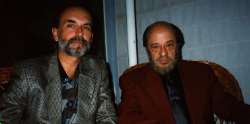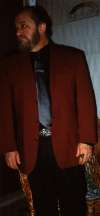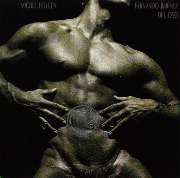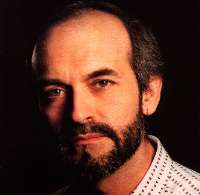THE
SONIC ASTRAL VOYAGE
OF
MICHEL HUYGEN & JIMÉNEZ DEL OSO
By: M.Montes & J.Munnshe (1996)
 The latest activities
by Michel Huygen
(Neuronium) are, as usual, amazing. Among them, there
is the release of his album Astralia,
where he has collaborated with Dr. Jiménez del Oso,
a famous researcher from Spain of enigmatic phenomena, to unite music
and literature in a sonic experiment that reveals us the darkest face
of his music. We interviewed Huygen in his home some
time before this CD was released, and also some time after that, we had
a conversation with him and Jiménez del Oso at
a press conference on the occasion of the release of this CD attended
by several personalities in the artistic and cultural world, including
besides several personalities from other areas, like for instance the
consul of Belgium. From both encounters we have selected the most
interesting comments, and we have written this article with them.
The latest activities
by Michel Huygen
(Neuronium) are, as usual, amazing. Among them, there
is the release of his album Astralia,
where he has collaborated with Dr. Jiménez del Oso,
a famous researcher from Spain of enigmatic phenomena, to unite music
and literature in a sonic experiment that reveals us the darkest face
of his music. We interviewed Huygen in his home some
time before this CD was released, and also some time after that, we had
a conversation with him and Jiménez del Oso at
a press conference on the occasion of the release of this CD attended
by several personalities in the artistic and cultural world, including
besides several personalities from other areas, like for instance the
consul of Belgium. From both encounters we have selected the most
interesting comments, and we have written this article with them.
Michel Huygen
is a very friendly, nice person. He is very accessible, he treats his
fans like friends, and he shows how an artist of this stature can keep
the humility of a common man. The same can be said of Jiménez
del Oso, a very well-known character in Spain and other
countries due to the television programs he has conducted and sponsored.
 Huygen
initiated his way into Cosmic Music in the early
seventies, founding the band Neuronium in 1976, of
which he is the only member since 1983. He has recorded more than
twenty records and has composed soundtracks for movies and television.
He has collaborated in other works with different artists among whom
most noteworthy is Vangelis.
He has given live performances with great success, like for example at
the British festival UK Electronica. He also has undertaken diverse
activities associated to the musical avant-garde, ranging from the
implementation of the Department of Electronic Music of the Centro de
Arte Reina Sofía (Arts Center Queen Sophie), to becoming the
producer of some electronic musicians, among them Trans-X
(the Techno band led by Pascal Languirand that in the
mid eighties sold several millions of copies of his theme Living
on Video).
Huygen
initiated his way into Cosmic Music in the early
seventies, founding the band Neuronium in 1976, of
which he is the only member since 1983. He has recorded more than
twenty records and has composed soundtracks for movies and television.
He has collaborated in other works with different artists among whom
most noteworthy is Vangelis.
He has given live performances with great success, like for example at
the British festival UK Electronica. He also has undertaken diverse
activities associated to the musical avant-garde, ranging from the
implementation of the Department of Electronic Music of the Centro de
Arte Reina Sofía (Arts Center Queen Sophie), to becoming the
producer of some electronic musicians, among them Trans-X
(the Techno band led by Pascal Languirand that in the
mid eighties sold several millions of copies of his theme Living
on Video).
Jiménez del Oso
has combined his task as a researcher and his divulgative work of
mysterious issues, with literature and painting. In the seventies, he
began to conduct and present the weekly program Más
Allá (Beyond), on the state television channel
(TVE), having a nationwide coverage. This program, devoted to the
research and popularization of enigmatic events, constituted as well
one of the first paths throughout which the strange, alternative and
electronic musics began to spread among the Spanish audience. These
kinds of music turned out to be the perfect soundtrack for the reports
on UFO sightings, events that could be labelled as paranormal, and
similar questions. Jiménez del Oso personally
used to take care of the musical selection, often bringing the records
that were played from his own home. As time went by, Huygen
and Jiménez del Oso came into contact as both
of them had common interests and each one of them was familiar with the
work of the other. They began their professional relationship as Huygen
created several soundtracks for some productions by Jiménez
del Oso. The most important ones are compiled in the albums Olim
and En busca del misterio (In Search of Mystery).
 In Astralia
both of them have shaped an unusual collaboration. Designed as the
re-creation of an astral voyage, the album combines Huygen's
music with a narration written by Jiménez del Oso,
that he himself narrates. The result is a ghostly, unearthly odyssey. "The
compact disc is very complex. Because we begin, from a narrative and
musical point of view, in Egypt, and we end up in the Cosmos".
The mutual understanding between both of them has been fundamental so
as to achieve a solid, homogeneous result. "Since the first
moment, each one of us understood what the other had in mind".
This is an unusual album indeed. Not only because it includes a
literary segment, but also because it is designed to be listened to in
some given circumstances which enhance the effect that Astralia
has on the imagination of the listener. "This is why we
have included in the CD leaflet some 'Instructions for Use'. We are
aware that the disc must be listened to exactly as we advise in these
instructions. It is not suitable to be played in public, nor is it
ambient music. This is obvious ever since the first moments of the
recording".
In Astralia
both of them have shaped an unusual collaboration. Designed as the
re-creation of an astral voyage, the album combines Huygen's
music with a narration written by Jiménez del Oso,
that he himself narrates. The result is a ghostly, unearthly odyssey. "The
compact disc is very complex. Because we begin, from a narrative and
musical point of view, in Egypt, and we end up in the Cosmos".
The mutual understanding between both of them has been fundamental so
as to achieve a solid, homogeneous result. "Since the first
moment, each one of us understood what the other had in mind".
This is an unusual album indeed. Not only because it includes a
literary segment, but also because it is designed to be listened to in
some given circumstances which enhance the effect that Astralia
has on the imagination of the listener. "This is why we
have included in the CD leaflet some 'Instructions for Use'. We are
aware that the disc must be listened to exactly as we advise in these
instructions. It is not suitable to be played in public, nor is it
ambient music. This is obvious ever since the first moments of the
recording".
In the CD sleeve it is described as "the
first natural and musical relief for stress without contraindications",
and therefore the work is presented as a relaxing product. However,
when they were finishing the recording, the authors feared that perhaps
they would have achieved the opposite effect to what they intended in
fact, as they had endowed their work with such a depth that it could
cause fear rather than calming the listener. Both the music and the
text are, in actual fact, on that very suggestive edge that separates
the fear for the unknown from the fascination to explore new worlds.
Although the general outline of the album rather points towards that
second perception, it cannot be denied that there are some musical and
literary passages that could provoke sensations of fear to easily
impressionable people. With respect to what the muscular torso printed
on the cover of the CD symbolizes, they explain us that it is a
reference to certain spiritual beliefs that consider the  human body as a series of energy centres
sited in different parts, among which most remarkable is the one placed
on the stomach.
human body as a series of energy centres
sited in different parts, among which most remarkable is the one placed
on the stomach.
Apart from releasing Astralia, Huygen
is involved in the preparation of several editions marked by the 20th
anniversary of the foundation of Neuronium (in 1996)
and the 20th anniversary of the release of the first record by Neuronium
(1997).
As for Jiménez del Oso,
among his latest activities it should be pointed out that he directs
the new magazine called Enigmas since recent times, and also
that he organized a collection of books on enigmatic issues, called Nueva
Biblioteca de los Temas Ocultos (New Library of The Occult
Themes), published during 1995-96.
 Previous Page
(Features/News)
Previous Page
(Features/News)
 The latest activities
by Michel Huygen
(Neuronium) are, as usual, amazing. Among them, there
is the release of his album Astralia,
where he has collaborated with Dr. Jiménez del Oso,
a famous researcher from Spain of enigmatic phenomena, to unite music
and literature in a sonic experiment that reveals us the darkest face
of his music. We interviewed Huygen in his home some
time before this CD was released, and also some time after that, we had
a conversation with him and Jiménez del Oso at
a press conference on the occasion of the release of this CD attended
by several personalities in the artistic and cultural world, including
besides several personalities from other areas, like for instance the
consul of Belgium. From both encounters we have selected the most
interesting comments, and we have written this article with them.
The latest activities
by Michel Huygen
(Neuronium) are, as usual, amazing. Among them, there
is the release of his album Astralia,
where he has collaborated with Dr. Jiménez del Oso,
a famous researcher from Spain of enigmatic phenomena, to unite music
and literature in a sonic experiment that reveals us the darkest face
of his music. We interviewed Huygen in his home some
time before this CD was released, and also some time after that, we had
a conversation with him and Jiménez del Oso at
a press conference on the occasion of the release of this CD attended
by several personalities in the artistic and cultural world, including
besides several personalities from other areas, like for instance the
consul of Belgium. From both encounters we have selected the most
interesting comments, and we have written this article with them. Huygen
initiated his way into Cosmic Music in the early
seventies, founding the band Neuronium in 1976, of
which he is the only member since 1983. He has recorded more than
twenty records and has composed soundtracks for movies and television.
He has collaborated in other works with different artists among whom
most noteworthy is
Huygen
initiated his way into Cosmic Music in the early
seventies, founding the band Neuronium in 1976, of
which he is the only member since 1983. He has recorded more than
twenty records and has composed soundtracks for movies and television.
He has collaborated in other works with different artists among whom
most noteworthy is 
 human body as a series of energy centres
sited in different parts, among which most remarkable is the one placed
on the stomach.
human body as a series of energy centres
sited in different parts, among which most remarkable is the one placed
on the stomach.